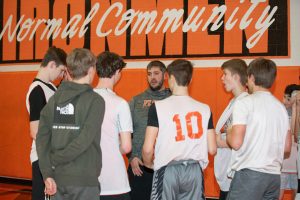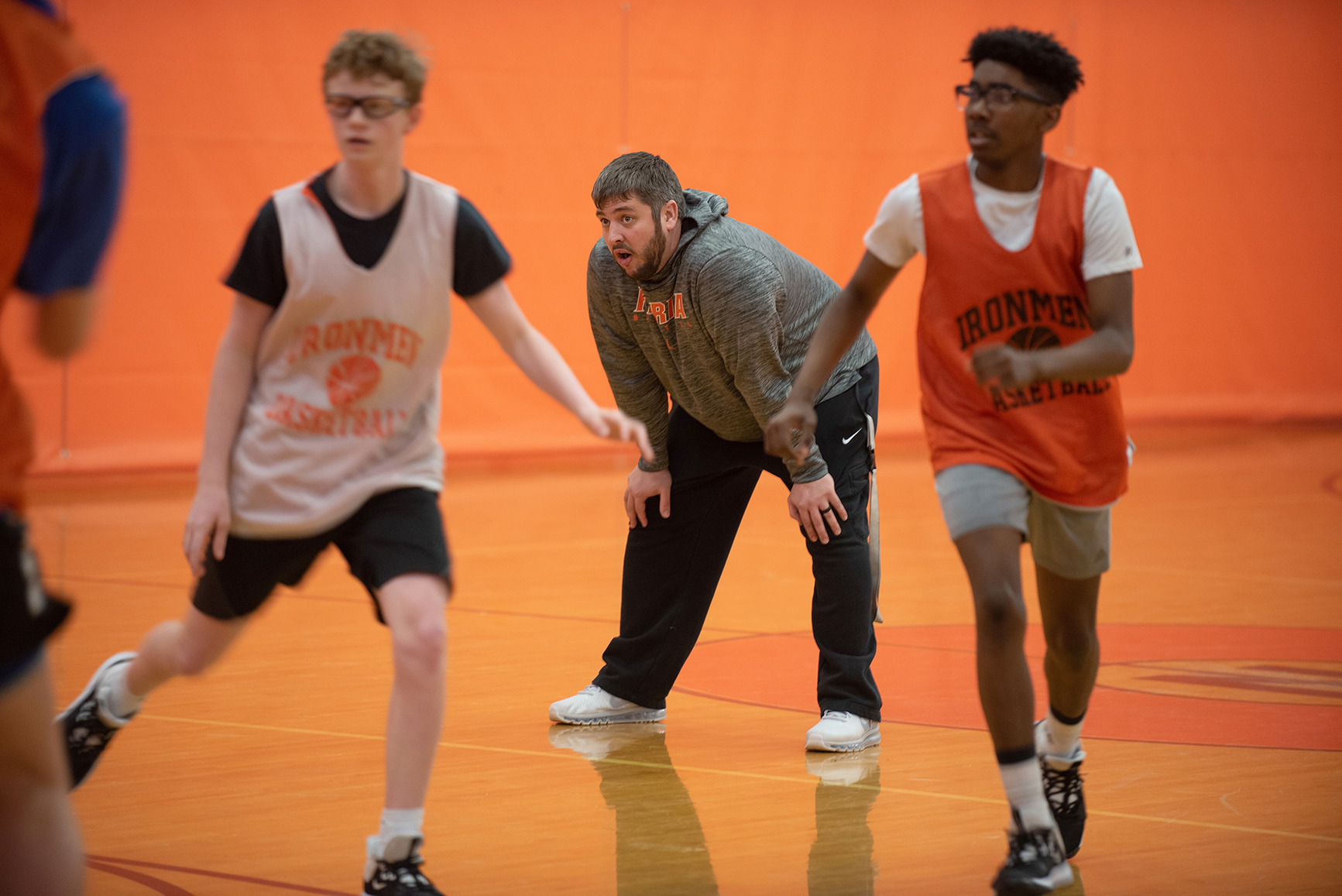Twelve minutes felt like two hours.
At first the teacher didn’t think the gun the student drew from his backpack was real. But then a bullet dropped to the floor.
Derrick Schonauer ’12 shouldn’t have been teaching health education on that rainy day in September, only 12 days into the school year. A month earlier, he was working for an apartment rental company, still looking for his first teaching job when he got a call about a last-minute opening. On the same day he interviewed at Normal Community High School, he was hired.
On September 7, 2012, there were only a few minutes left in the first-hour health class when a freshman grabbed the teacher’s stool and said it was his class now. He told the class of about 30 students that he wanted them to listen to his story, as he pulled out a handgun.
“I think about how lucky we all are. They made it. We walked out of that situation. My life changed drastically after that, and I know theirs did too.”—Derrick Schonauer
The class froze. Schonauer tried to calm the gun-wielding student, assuring him they were his friends and they were listening. Schonauer had a relationship with the student because he happened to student teach at his middle school. Reaching for his cell phone, the teacher quietly texted another teacher that there was a gun in the classroom. That teacher, however, didn’t have his phone with him, so he didn’t see the text. Schonauer also dialed 911 but knew he couldn’t speak.
The minutes went by in slow motion, as the boy told the class about his struggles, his rough transition to high school, and how he had been bullied.
“I think it was more a cry for help,” Schonauer said. “There were multiple opportunities for him to do harm.”
Inside his backpack, the student had two more guns, hatchets, ammunition, and a canteen of accelerant.
A girl near the door started crying, and the boy said he was not going to hurt her. He asked everyone to give her a hug, and when the students moved toward her, several ran out of the room so quickly they left their sandals behind.
That angered the boy. He fired into the ceiling and slammed the door. Then he told them, ”That’s not going to happen again,” as he lined them up against the wall and took their phones.
The students who escaped fled to locker rooms, classrooms, anywhere they could hide. The school was locked down.
Schonauer never took his eyes off the student. Although they were two desks apart, when the boy set down the gun for a second, the teacher made his move. Schonauer grabbed the gun, and he and another student subdued the boy until police arrived. No one had been injured.

Derrick Schonauer still teaches at Normal Community High School seven years after the life-changing incident.
Seven years later, Schonauer is still teaching and coaching at Normal Community High School. At 32, he and his wife, Kelsey (Williams) ’13, have a 16-month-old daughter and are expecting another girl in June.
Although the students who were in the classroom that day are in their early 20s now, he still gets emails from them, telling them they graduated from college, they’re getting married, starting careers. That’s when the impact of that day hits him again.
“I think about how lucky we all are,” Schonauer said. “They made it. We walked out of that situation. My life changed drastically after that, and I know theirs did too.”
Megan Egenes was in the classroom that day. She will graduate from Indiana Wesleyan University in April, with a degree in photography. For a long time, she didn’t want to talk about that day. But during her freshman year in college, she gave a speech on it.
“I couldn’t even practice it without getting overwhelmed, but it was the most liberating thing I’ve ever done,” she said.
Although Schonauer is uncomfortable with the word “hero,” there’s no doubt in Egenes’ mind that he stopped a tragedy.
“Mr. Schonauer is the most humble person I’ve ever known,” she said. “He will always deny it, but he is the very definition of a hero.”
Trevor Bixby was another student in the room that day. The football player was wearing his jersey because it was game day. When the armed student told them to line up, Bixby thought he would be one of the first to go.
“He was talking about being bullied, and sometimes it’s the athletic guys who bully people so I felt like that might have been a factor when he was deciding who to shoot,” Bixby said.
Bixby didn’t think he would survive that day, but now he’s a student at Heartland Community College, working on becoming a physical therapy assistant.
The relationship the teacher had with the armed student may have made all the difference. Even as a student teacher, he made it a point to talk to the troubled teen every day, even if he only got a thumbs up or thumbs down response.
“He had his struggles. I’d say, ‘Hey, how’s it going?’ He got that from me every day.”
That’s a message he would pass along to new teachers. Reach out to every student and make sure they know you’re there for them.
“Make a connection,” he said. “Just show that you care.”
Last summer, Schonauer ran into his former student for the first time, at a dollar store.
“I heard, ‘Hey sir, how’s it going?’ I looked up and saw that it was him.”
There was no conversation, but the brief encounter took Schonauer back to that harrowing day. He had to spend several minutes in an aisle before he could leave the store.
Schonauer doesn’t think the student ever knew his name. He received a written apology years ago, sent to the school and addressed to “the teacher who was in the room.”
The Normal Community High School incident happened three months before the Sandy Hook Elementary School shooting in Newtown, Connecticut. There have been at least 563 incidents of gunfire on school grounds since 2013, according to Everytown, a nonprofit that tracks school shootings.
Schonauer’s freshmen this year were first-graders in fall 2012. Some remember the incident and even ask him about it. Sometimes he talks about the experience, along with post-traumatic stress syndrome in his health class.
“When someone shoots bottle rockets off, my mind goes to a different place,” Schonauer said. “They think they are the only ones going through things. When they hear I went through something traumatic, they learn you take it day by day, and some days are tougher than others.
When Schonauer started at Illinois State University, he wasn’t planning on teaching. He thought he would become an athletic trainer. Instead, he entered the University’s school health education program.
“Somehow I found myself in the teaching program,” he said. “ Dr. (Adrian) Lyde and Dr. (Mark) Temple had a tremendous impact on me. They had such a passion for health ed and loved what they were doing. They made me love it too.”
His experience has changed how he teaches.
“You slow down and look at things a little differently,” he said. “Everybody’s got their problems and being in health, we can talk about those problems. We can talk about emotional health and mental health and how important it is to maintain a balance.”


Teachers must be authentic to make a difference.